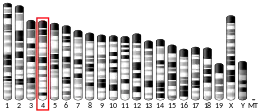FREM1
پروتئین ماتریکس برونسلولی ۱ مرتبط با FRAS1 (انگلیسی: FRAS1-related extracellular matrix protein 1) یک پروتئین است که در انسان توسط ژن «FREM1» کُدگذاری میشود.[4][5][6]
| FREM1 | |||||||||||||||||||||||||
|---|---|---|---|---|---|---|---|---|---|---|---|---|---|---|---|---|---|---|---|---|---|---|---|---|---|
| معینکنندهها | |||||||||||||||||||||||||
| نامهای دیگر | FREM1, BNAR, C9orf143, C9orf145, C9orf154, MOTA, TILRR, TRIGNO2, FRAS1 related extracellular matrix 1 | ||||||||||||||||||||||||
| شناسههای بیرونی | OMIM: 608944 MGI: 2670972 HomoloGene: 27049 GeneCards: FREM1 | ||||||||||||||||||||||||
| |||||||||||||||||||||||||
| |||||||||||||||||||||||||
| همساختشناسی | |||||||||||||||||||||||||
| گونهها | انسان | موش | |||||||||||||||||||||||
| Entrez | |||||||||||||||||||||||||
| آنسامبل | |||||||||||||||||||||||||
| یونیپروت | |||||||||||||||||||||||||
| RefSeq (mRNA) | |||||||||||||||||||||||||
| RefSeq (پروتئین) | |||||||||||||||||||||||||
| موقعیت (UCSC) | n/a | Chr : 82.9 – 83.05 Mb | |||||||||||||||||||||||
| جستجوی PubMed | [2] | [3] | |||||||||||||||||||||||
| ویکیداده | |||||||||||||||||||||||||
| |||||||||||||||||||||||||
منابع
- GRCm38: Ensembl release 89: ENSMUSG00000059049 - Ensembl, May 2017
- "Human PubMed Reference:". National Center for Biotechnology Information, U.S. National Library of Medicine.
- "Mouse PubMed Reference:". National Center for Biotechnology Information, U.S. National Library of Medicine.
- Puente XS, Sanchez LM, Overall CM, Lopez-Otin C (Jul 2003). "Human and mouse proteases: a comparative genomic approach". Nat Rev Genet. 4 (7): 544–58. doi:10.1038/nrg1111. PMID 12838346.
- Smyth I, Du X, Taylor MS, Justice MJ, Beutler B, Jackson IJ (Sep 2004). "The extracellular matrix gene Frem1 is essential for the normal adhesion of the embryonic epidermis". Proc Natl Acad Sci U S A. 101 (37): 13560–5. doi:10.1073/pnas.0402760101. PMC 518794. PMID 15345741.
- "Entrez Gene: FREM1 FRAS1 related extracellular matrix 1".
- مشارکتکنندگان ویکیپدیا. «FREM1». در دانشنامهٔ ویکیپدیای انگلیسی، بازبینیشده در ۱۴ سپتامبر ۲۰۱۹.
برای مطالعهٔ بیشتر
- Bonaldo MF, Lennon G, Soares MB (1997). "Normalization and subtraction: two approaches to facilitate gene discovery". Genome Res. 6 (9): 791–806. doi:10.1101/gr.6.9.791. PMID 8889548.
- Strausberg RL, Feingold EA, Grouse LH, et al. (2003). "Generation and initial analysis of more than 15,000 full-length human and mouse cDNA sequences". Proc. Natl. Acad. Sci. U.S.A. 99 (26): 16899–903. doi:10.1073/pnas.242603899. PMC 139241. PMID 12477932.
- Ota T, Suzuki Y, Nishikawa T, et al. (2004). "Complete sequencing and characterization of 21,243 full-length human cDNAs". Nat. Genet. 36 (1): 40–5. doi:10.1038/ng1285. PMID 14702039.
- Brandenberger R, Wei H, Zhang S, et al. (2005). "Transcriptome characterization elucidates signaling networks that control human ES cell growth and differentiation". Nat. Biotechnol. 22 (6): 707–16. doi:10.1038/nbt971. PMID 15146197.
- Humphray SJ, Oliver K, Hunt AR, et al. (2004). "DNA sequence and analysis of human chromosome 9". Nature. 429 (6990): 369–74. doi:10.1038/nature02465. PMC 2734081. PMID 15164053.
- Gerhard DS, Wagner L, Feingold EA, et al. (2004). "The Status, Quality, and Expansion of the NIH Full-Length cDNA Project: The Mammalian Gene Collection (MGC)". Genome Res. 14 (10B): 2121–7. doi:10.1101/gr.2596504. PMC 528928. PMID 15489334.
- Kiyozumi D, Osada A, Sugimoto N, et al. (2005). "Identification of a novel cell-adhesive protein spatiotemporally expressed in the basement membrane of mouse developing hair follicle". Exp. Cell Res. 306 (1): 9–23. doi:10.1016/j.yexcr.2005.01.020. PMID 15878328.
This article is issued from Wikipedia. The text is licensed under Creative Commons - Attribution - Sharealike. Additional terms may apply for the media files.

